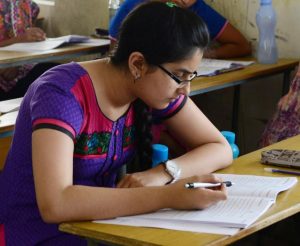Following is the Senior Intermediate Model Paper for IPE examinations in Andhra Pradesh and Telangana States. Both the states have same syllabus and the pattern of exam also same. This model paper is for Physics (Paper – 2). Candidates can practice this paper for good marks in the exam. All the best.
Time : 3 Hours Max Marks : 60
Section A
I. VSAQ: Answer all the following questions. 10 x 2= 20 M
- What is Myopia? How can it be corrected?
- What are the units of magnetic moments and magnetic induction?
- Define magnetic inclination or angle of dip?
- Magnetic lines form continuous closed loops. Why?
- A transformer converts 200V AC into 2000 V AC. Calculate the number of turns in the secondary if the primary has 10 turns.
- What aret he uses of microwaves?
- What is “work function”?
- State Heisenberg’s Uncertainity Principle.
- What is a p – type semiconductor? What are the majority and minority charge carriers in it.
- Define Modulation. Why is it necessary?
SECTION B
II. SAQ: Answer any SIX of the following questions. 6 x 4 = 24 M - With a neat labeled diagram, expalin the formation of image in a simple microscope.
- How do you determine the resolving power of your eye?
- Derive an expression for the intensity of the electric field at a point on the axial line of an electric dipole.
- Derive an expression for the capacitance of a parallel plate capacitor.
- State and explain Biot – Savart’s law.
- Describe the ways in which eddy currents are used to advantage.
- What are the limitations of Bohr’s theory of hydrogen atom?
- Describe how a semiconductor diode is used as a half-wave rectifier.
SECTION C
III. LAQ: Answer any TWO of the following questions. 2 x 8 = 16 M - Explain the formation of stationary waves in an air column enclosed in open pipe. Derive the equations for the frequencies of the harmonics produced. A open organ pipe 85 cm long is sounded. If the velocity of sound is 340 m/s, what is the fundamental frequency of vibration of the air column?
- State the working principle of potentiometer. Explain with help of circuit diagram how the emf of two primary cells are compared by using potentiometer. A potentiometer wire is 5m long and a potential difference of 6V is maintained between its ends. Find the emf of a cell
which balances against a length of 180 cm of the potentiometer wire. - What is radioactivity? State the law of radioactive decay. Show that radioactive decay is exponential in nature. The half life of radium is 1600 years. How much time does 1g of radium take to reduce to 0.125g?
